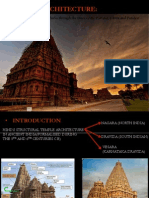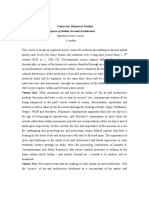Fractal Geometry in Indian Architecture
Fractal Geometry in Indian Architecture
Uploaded by
Jitendra FarkadeCopyright:
Available Formats
Fractal Geometry in Indian Architecture
Fractal Geometry in Indian Architecture
Uploaded by
Jitendra FarkadeOriginal Description:
Copyright
Available Formats
Share this document
Did you find this document useful?
Is this content inappropriate?
Copyright:
Available Formats
Fractal Geometry in Indian Architecture
Fractal Geometry in Indian Architecture
Uploaded by
Jitendra FarkadeCopyright:
Available Formats
International Journal of Engineering Research & Technology (IJERT)
ISSN: 2278-0181
Vol. 4 Issue 05, May-2015
Role of Fractal Geometry in Indian
Hindu Temple Architecture
Dhrubajyoti Sardar S. Y. Kulkarni
M.Arch Scholar Professor & Former Head
Architecture & Planning Department, IIT Roorkee Architecture & Planning Department, IIT Roorkee
Roorkee, Uttarakhand, India Roorkee, Uttarakhand, India
Abstract The self-similar recursive geometry is known as According to the Fractal Foundation A fractal is a never-
Fractal. Hindu Philosophy describes the cosmos as holonomic ending pattern. Fractals are infinitely complex patterns that
and self-similar in nature. In the connection of this context, are self-similar across different scales. They are created by
fractal theory is being followed in Indian Hindu Temple repeating a simple process repeatedly in an ongoing feedback
Architecture much before the discovery of Fractal Theory. This
loop. Driven by recursion, fractals are images of dynamic
paper is an attempt to find out the role of fractals in different
elements of Indian Hindu temples. The study has extended from systems the pictures of Chaos. Geometrically, they exist in
the site plan level to the minute detailing level. The discussion between our familiar dimensions. Fractal patterns are
covers the elementary idea about the fractal theory and the extremely familiar, since nature is full of fractals. For
basic structure of Hindu temples with supportive and self- instance: trees, rivers, coastlines, mountains, clouds,
explanatory visuals and analysis of the topic. It also focuses on seashells, hurricanes, etc. Abstract fractals such as the
the behavioural actions of fractals in Hindu temples and on the Mandelbrot Set can be generated by a computer calculating
reasons behind its successful occurrence. a simple equation over and over.
Keywords Fractal geometry; Hindu cosmology; Hindu
temple architecture; Iteration; Self-similar; Repetition Benot B. Mandelbrot (20 November 1924 14 October
2010) was a Polish-born, French and
INTRODUCTION American mathematician, who first compiled all the research
Ancient Indian mathematicians were very skilful in geometry. and ideas of hundreds of years about self-similarity and
They used the knowledge of geometry in other disciplines coined the term Fractal.
also. They derived many of the comprehensive conclusions
with the help of geometry. The Indian old scripts are the Fractal geometry has different roles in different sectors. In
evidences of those practices. The concept of progression can Architecture, it acts as a mode of expression to reveal the
also be applied in the geometry. When this progression held beauty of the complexity. It gives wings to the ideas of an
in a proper manner or following a rule, it becomes a process, architect and reflects the process of energy flow of the
which has several names like iteration, repetition etc. universe through buildings and monuments. Hindu temples
However, at the end of the process, the outcome turns into a are one of the best examples of buildings with the fractal
beautiful illusion. The Indians understood this beautiful phenomenon, which were constructed in the past, long before
illusion by practice. They were creative minds. They proved the evolution of Fractal Theory.
their efficiency not only in applied science but also in arts
and crafts. They worshipped the nature and they were very 2. Fractal Theory & Hindu Cosmology
eager to reveal the mystery of creation. Somehow they got Self-similarity is the phenomenon of each part being
the hints of creation; the principles of self-similarity, geometrically similar to the whole. It is the core concept of
iteration, repetition. They observed that, in the mountains, in the Fractal Theory. Interestingly, self-similarity is one of the
the trees, in ground covers, in water; everything follows those basic principles of organization in the Hindu Temple
principles. Even living beings are not the exceptions. Then Architecture. The Hindu Temple is designed and constructed
they followed those principles in their creations. They gave as miniature forms of the Cosmos as envisioned in Hindu
their tribute as a form of temple to the ultimate creator by philosophy and beliefs.
following the principles of his creation. The discussions Hindu Philosophy describes the cosmos as holonomic. The
below is a small trial to reveal those process in which the holonomic character implies the virtue of self-similarity,
ancient builders incorporate the basic principles of fractal homogeneity, isotropy and symmetries of various kinds. Like
geometry i.e. self-similarity, repetition and iteration in the a hologram, each fragment of the cosmos is considered to be
making of Indian temples. whole in it and to contain information similar to the whole.
1. Fractal Geometry 3. Fractals in the Formation of Temples
The term Fractal actually comes from the Latin word The history of the evolution of the Indian Hindu Temples is a
Fractus which means broken. Fractal means, the recursive very vast field of study. Starting from the cave temples to the
geometrical forms, bearing self-similarity on different scales. palatial temple complexes, all styles have followed an
IJERTV4IS050709 www.ijert.org 532
(This work is licensed under a Creative Commons Attribution 4.0 International License.)
International Journal of Engineering Research & Technology (IJERT)
ISSN: 2278-0181
Vol. 4 Issue 05, May-2015
exhaustive path of evolution through experimentation. During
Gupta period and onwards the temple architecture in India
flourished in a much disciplined manner. The architects,
artisans and artisans gradually developed the aesthetic sense
of complexity. As a result, the formation of Hindu temples
became more complex and embodied an inherent sense of
fractal geometry.
1. 2.
4. VASTUPURUSHAMANDALA
The Vastupurusha (figure 01) is a key concept in Hindu
temple architecture. The plan of the Hindu temple strictly
follows the principles described in Puranas related to the
Vastupurushamandala. It follows three basic sets of iteration
and further sub-categories. Limited technical expertise exists 3. 4.
about all the mandalas and their formulation through
alteration and repetition of fractals. Figure 03: 1.Basic diagram, 2.Generating nested squares and circles,
3.Showing diagonal squares, 4.generation of plan forms
Source: Hardy, Adam. The Temple Architecture of India
6. VINYASASUTRA [LAYOUT & ORIENTATION]
Figure 01: The image of Vastupurushamandala with 64 blocks for different
deities
Source: http://hindutemplearchitectureandsculpture-
filiault.wikispaces.com/file/view/Vastu_Canon.png/182843879/800x380/Vas
tu_Canon.png
The above figure shows the traditional Vastupurushamandala.
There are mainly two types of mandalas, one is with sixty-
four squares and another with eighty-one squares where each
square is dedicated to a deity. (see figure 02 below)
Figure 02: Fractal characteristics of different mandalas and their iterations
from the sakala mandala
From left: Paramasaayika, Pitah, Sakala, Pechaka, Mahapitah, Manduka
Chandita mandala
Source: I. Md Rian et al. / Building and Environment 42 (2007) 40934107
5. TEMPLE GEOMETRY
Figure 04: Plan of Brihadeshwara Temple, Thanjavur, showing the
Vinyasasutra
In Hindu temple architecture, geometry always plays a vital Source: http://1.bp.blogspot.com/-
and enigmatic role. The geometry of a plan starts with a line, dni34cWSH3k/UZXC_pg5RSI/AAAAAAAAAgs/qcED3dcmpT4/s1600/tem
forming an angle, evolving a triangle, then a square and ple+archit.png
distinctly a circle and so on, ultimately deriving complex In Sanskrit Vinyaasa means orientation and sutra means
forms. As per the previous discussion, the occurrence of thread, line or axis. It is related with the lay out and
complexity, results into self-similarity and further it leads to orientation of temple plans. Vastupurushamandala is the base
the occurrence of fractal geometry. Geometry is a disciplined of evolution of a temple plan. Vinyasasutra comes into play
field and the fractals follow it. Both of them have definite after the initial evolution of the temple plan. During the
paths of action. In following diagrams as shown in figure 03 determination of the axis and orientation of the temple and its
below, the role of fractal theory in basic geometry of Hindu surroundings, ancient architects used to follow the process
temple plans is exhibited. described in Hindu scripts like Vastushashtra, Manasara etc.
However, all the plans followed geometries with fractal
character. It is postulated that, some of them were made
consciously and some unconsciously. (See figure 04).
IJERTV4IS050709 www.ijert.org 533
(This work is licensed under a Creative Commons Attribution 4.0 International License.)
International Journal of Engineering Research & Technology (IJERT)
ISSN: 2278-0181
Vol. 4 Issue 05, May-2015
7. TEMPLE COMPLEX gradually take the shape following the fractal theory (figure
06).
The design of the temple complex varies according to the
style of the temple. Most of the temples in North India do not
have a boundary wall. However, in the South Indian style, it
is an essential design element of the temple complex. In some
areas, the entire temple complex consists of only the
Mulaprasada. To the trained eye, the miniature fractals of the
main shrine stand out in a well-designed temple complex. All Figure 06: a.Shrine alone, b.Shrine with porch, c.Shrine with Antarala and
the elements including the Toranas, Gopurams, miniature porch, d.Sarvatobhadra shrine with four entrances
Source: Hardy, Adam. The Temple Architecture of India
shrines, Pushkarinis etc. either have been repeated in a
disciplined order or have been constructed following the rules
of fractal theory. The basic plan form also followed the iteration and gradually
became more complex from a simple quadrangle or square
plan. It follows the repetition in recesses or in projections.
However, these repetitions followed a discipline. It is
maintaining an axis. In the figure 07 below one can see how
one formation is evolved from a simple square a to e. It
only creates basic projections in between cardinal points.
Figure f to i follow the repetition of recesses. Figures j to
m are the amalgamated formations. Accordingly, the others
also follow certain geometric rules for iteration.
Figure 07: a. Simple square plan, (b-e).Square plan with simple projections,
(f-i).Staggered square plan without recesses, (j-m).Staggered square plan
Figure 05: Site plan of Minakshi Sundareswara Temple, Madurai with recesses, (n-o).Stepped diamond plan, (p-q).Stellate plan with
Source: http://www.art-and-archaeology.com/india/madurai/minplan.jpg orthogonal central projection, (r-s).Special stellate plans, (t-v).Uniform
stellate plans based on rotated-square star.
The above example of Minakshi Sundareswara Temple Source: Hardy, Adam. The Temple Architecture of India
(figure 05) shows how fractal has worked starting from the
boundary wall to the main shrine. One can notice the 9. ELEVATION OF THE TEMPLE
positioning of the Torana, the placement of miniature replicas Fractal also has a great impact on temple elevations. As is the
of the main shrine around itself, the hypostyle halls, etc. have case of two-dimensional plans, fractal also controls the
evolved with the feature of self-similarity. formation of the elevations in three dimensions. Elevation
treatment of temple differs according to regions in India.
8. EVOLUTION OF PLAN FORMS THROUGH Therefore, tracing out typical examples, can be exhaustive.
ITERATION The following divisions are almost common to all temples
In keeping with the site plan, the plan of the main temple throughout India.
structure also follows the rule of fractals. At the very
beginning, the steps are the simplest form of fractals from Overall, the whole temple structure in three dimensions form
which the halls or mandapas grow expansively. First, the expresses the self-similarity in the structure. On consideration
Mukhamandapa or the hall of entrance and then the of silhouettes of temple structures, a visual language of
Ardhamandapa, the half-heighted hall and finally the Maha gradual progression starting from the base to the spires is
Mandapa, the grand hall are positioned. After the mandapas, prominent as shown in figure 08.
comes the Mulaprasada, which encloses the Garbhagriha, the
inner sanctum. The enclosures of these halls and the spaces
IJERTV4IS050709 www.ijert.org 534
(This work is licensed under a Creative Commons Attribution 4.0 International License.)
International Journal of Engineering Research & Technology (IJERT)
ISSN: 2278-0181
Vol. 4 Issue 05, May-2015
Jangha
Jangha is the walled section of the shrine (figure 11) acting,
as the enclosure of the mandapas and Garbhagriha. Fractals
are worked in two different ways in its formation. Initially it
is generated from the folds at the very base layer, which
follow the iteration. The types of decorative works on the
Jangha at the outer level are also self-similar and repetitive.
Figure 08: Silhouette of Kandariya Mahadev Temple
Source:http://ak5.picdn.net/shutterstock/videos/1388590/preview/stock-
footage-a-spire-on-an-indian-temple-stands-silhouetted-against-the-sun.jpg
One can divide the temple into several parts like Pitha,
Vedibandha, Jangha, Varandika, Sikhara and Ghanta. Ghanta
is actually a part of Shikhara but its features are so distinct,
Figure 11: Jangha of a typical North Indian Temple
one can consider it as a separate entity. The above-mentioned Source: Hardy, Adam. The Temple Architecture of India
parts are similar in all Nagara temples, but they have different
denominations in different places. Varandika
Varandika is the cornice part of the temple. Huge long chunk
Pitha of stones are placed along the inner side to form the cornice.
Pitha is the base or the altar on which the structure grows However, on the outside, it is quite decorative (as shown in
along the central axis. Pitha is also divided into several parts figure 12) and it also forms the connection between the
founded on the Khura, Kumbha, Antarpatrika, Kalasha and Jangha and the Sikhara, the two most important parts of a
kapotali. All the fragments are basic moulds and repetitive in temple.
form. In figure 09 below, the fractals of the central mould
repeat in numbers around the plan in different scales.
Figure 09: Pitha of a typical North Indian Temple
Source: Hardy, Adam. The Temple Architecture of India Figure 12: Varandika of a typical North Indian Temple
Source: Hardy, Adam. The Temple Architecture of India
Vedibandha Sikhara
Vedibandha is the next upper part of the pitha. It is mainly a Sikhara is the identity of a temple. All the variations in
connection between pitha and jangha. It has almost the same temple architecture are mainly because of the variation in its
character of that of pitha. The mouldings and the typical parts formation. (figure 13)
are mostly similar in both the cases. The only difference in
this case is that the sculpting of moulds is more decorative.
One can find similar type of small repetitive ornamental
mouldings at the central space of every wall section in figure
10.
Figure 10: Vedibandha of a typical North Indian Temple Source: Hardy,
Adam. The Temple Architecture of India
Figure 13: Sikhara of a typical North Indian Temple
Source: Hardy, Adam. The Temple Architecture of India
IJERTV4IS050709 www.ijert.org 535
(This work is licensed under a Creative Commons Attribution 4.0 International License.)
International Journal of Engineering Research & Technology (IJERT)
ISSN: 2278-0181
Vol. 4 Issue 05, May-2015
Ghanta 11. REASON BEHIND THE USE OF FRACTAL
Ghanta is the topmost part of the temple. It is a part of the GEOMETRY IN HINDU TEMPLE ARCHITECTURE
Sikhara. It also has separate parts with Kantha or Griva as the
base and gradually Amlaka, Padmashirshaka, Kalasha, etc. The following are some probable reasons behind the use of
The connector of Sikhara and Ghanta is known as the Kantha Fractal Geometry in Hindu temple architecture.
or the Griva. In this section of the temple, fractal mainly
works in the Amlaka part by creating self-similar ribs. (as in a) It can be argued that, practicing fractals is none other
figure 14) than the implication of the sense of completeness since
the concept of fractals is that of the part to whole and
whole to part.
b) The fractal theory fully supports the Hindu philosophical
concept of one among all, all is one. It brings the
feeling of oneness (the concept of Atman).
c) It can bring a sense of strength, both structurally as well
as visually.
Figure 14: Ghanta of a typical North Indian Temple
Source: Hardy, Adam. The Temple Architecture of India d) Self-similar elements in the design, seek the attention of
the visitors and pilgrims repeatedly and gradually entice
The formation of Jangha also depends upon the formation them to think about it and create a clear state of mind
and style of the Sikhara as shown in the figure 15 below. It is with a holistic perception.
similar to the head and the structure. One fold is added to the
Jangha for every additional fold in the Sikhara. e) Self-similar repetition in structure generates an identity
of elements as well as form.
f) Experimentation can also be a reason behind the
evolution and realisation of fractal theory in Hindu
temple architecture through the ages.
g) The term, Self-similar brings a sense of modularity.
Therefore, it generates the same style of work using the
same modules, which saves resources. Local materials,
workmanship and time offer ease of execution across
huge structures, such as temples within the same region.
h) Making of similar kind of elements repeatedly generates
Figure 15: Image showing the interdependent formation process of Jangha a habit and practice and practice perfects the execution.
and Sikhara
Source: Hardy, Adam. The Temple Architecture of India
i) From an aesthetical viewpoint, a fractal geometry brings
about order in chaos and thereby a beauty in
complexity.
10. THE BEHAVIOURAL ATTRIBUTES OF ACTION OF
FRACTALS IN TEMPLES 12. CONCLUSION
The above study gives a brief idea about the relationship
From the above discussion about the role of fractal geometry between fractal theory and Hindu cosmology, role of fractal
in the formation of the Hindu temple, one major observation, geometry in Hindu temple architecture, behavioural attributes
which can be drawn, is that all the progression and iteration of action of fractals and possible reason behind them. It
have some specific behavioural attributes of action. endeavours to prove the essential role of fractals in Hindu
According to Professor Adam Hardy, the movements and the temple architecture.
behaviour of action are Projection1, Staggering2, Splitting3, In the view of the author, the above brief discussion about
Progressive Multiplication4 and Expanding Repetition5. fractals, Hindu temples and their inter-relationship has
renewed to their understanding of Hindu temple architecture.
Study of fractals and link it to the formation of temple make
the process easier of understanding the temples. It reveals the
mystery of this gigantic structures fold by fold. In every
element of these temples, there is a touch of fractal. This
paper is just a trial of highlighting them. However, there is
huge scope to study them in detail.
IJERTV4IS050709 www.ijert.org 536
(This work is licensed under a Creative Commons Attribution 4.0 International License.)
International Journal of Engineering Research & Technology (IJERT)
ISSN: 2278-0181
Vol. 4 Issue 05, May-2015
Notes
1. Projection of an embedded form almost by definition Acknowledgment
suggests emergence or emanation. In this process, the
base module projects self-similar miniatures or fractals The person who primarily inspires this study is Professor
forward, sideways, diagonally and backwards. This Adam Hardy (Professor, Cardiff University). His teaching
projection process can change its direction after a single and way of explaining temple architecture defines a new
progression. Like, initially, it can project moulds forward direction to understand the mystery of Hindu temple
and in the second turn, it projects the miniatures architecture. Thanks to him for providing the basic
diagonally. (Prof. Adam Hardy) knowledge and the related illustrations. Special thanks to
2. Staggering, multiple projection, or progressive stepping- Kirti Trivedi and William J Jackson. Their previous study
out, suggests expansion in stages on a serial emanation. helps a lot to enhance the findings of this paper. Another
Closely bunched offsets can also create the impression of person, who consistently helps in completing this paper, is
vibration from an inner energy. A staggered sequence of Ar. Aditi Baranwal. Thanks for her kind help.
forms, embedded one within the other, can be entirely at
one level (in which case the elements slide out like an
unfolding telescope), or step down as they step out. REFERENCES
(Prof. Adam Hardy) 1. Acharya, Prasanna Kumar. Hindu Architecture in India and Abroad;
3. Two aligned halves of something familiar as a whole Manasara series, Volume VI (Oxford University Press, 1946)
2. Hardy, Adam. The Temple Architecture of India (Great Britain: John
suggest that the whole has split; or even that the halves Wiley & sons. Ltd., 2007)
are still separating, especially if a projected form appears 3. Kramrisch, Stella. The Hindu Temple; Vol-1 & Vol-2 (New Delhi:
between them, as if emerging from a void. In this way, Motilal Banarsidass, Indological Book House, 1976)
basic forms split away and create fractals. (Prof. Adam 4. Vatsyayan, Kapila. The Square and the Circle of the Indian Arts (New
Delhi: Roli Books International, 1983)
Hardy)
4. Proliferation (thus growth of the whole, but not Journal Articles:
necessarily of the parts) is portrayed where elements are 1. Fractal geometry as the synthesis of Hindu cosmology in Kandariya
arranged in a sequence of rows, starting with one and Mahadev temple, Khajuraho by Iasef Md Rian, Jin-Ho Park et all
(Department of Architecture, Inha University & Chosun University,
then progressively increasing in number. This process South Korea, 2007)
actually creates similar objects in a order like binary tree. 2. Hindu Temple Fractals by William J. Jackson (Department of
(Prof. Adam Hardy) Religious Studies, IUPUI)
5. When growth is expressed in a series, the elements are 3. Hindu temples: models of a fractal universe by Kirti Trivedi
(Industrial Design Centre, Indian Institute of Technology, Powai,
self-similar but get progressively bigger. (Prof. Adam Bombay, 1989)
Hardy)
IJERTV4IS050709 www.ijert.org 537
(This work is licensed under a Creative Commons Attribution 4.0 International License.)
You might also like
- 2024 Zonal AssignmentsDocument18 pages2024 Zonal AssignmentsArnab BanerjeeNo ratings yet
- Tiger For BreakfastDocument311 pagesTiger For BreakfastramboriNo ratings yet
- PDF Critchlow Kenneth The Hidden Geometry of Flowers DL - PDFDocument180 pagesPDF Critchlow Kenneth The Hidden Geometry of Flowers DL - PDFRaluca Goga100% (5)
- Harmonic Proportion and Form in Nature, Art and ArchitectureFrom EverandHarmonic Proportion and Form in Nature, Art and ArchitectureRating: 4 out of 5 stars4/5 (1)
- Laws of Harmonious Colouring - David Ramsay HayDocument114 pagesLaws of Harmonious Colouring - David Ramsay HayMustafa MidzicNo ratings yet
- ToranaDocument1 pageToranaBhaswati MukherjeeNo ratings yet
- Building Jaipur - The Making of An Indian CityDocument199 pagesBuilding Jaipur - The Making of An Indian CityAnkit Kashmiri GuptaNo ratings yet
- Paintings of Bundelkhand: Some Remembered, Some Forgotten, Some not yet DiscoveredFrom EverandPaintings of Bundelkhand: Some Remembered, Some Forgotten, Some not yet DiscoveredNo ratings yet
- The Blue Cliff RecordDocument32 pagesThe Blue Cliff RecordJeff KlassenNo ratings yet
- The Sauptikaparvan of The Mahabharata: The Massacre at NightDocument185 pagesThe Sauptikaparvan of The Mahabharata: The Massacre at NightTeodora IoanaNo ratings yet
- The Geometry of Hindu TempleDocument40 pagesThe Geometry of Hindu TempleUday DokrasNo ratings yet
- Mathematics in Temple DesignsDocument151 pagesMathematics in Temple DesignsUday Dokras100% (4)
- Fractal Geometry As The Synthesis of Hindu Cosmology in Kandariya Mahadev Temple, KhajurahoDocument15 pagesFractal Geometry As The Synthesis of Hindu Cosmology in Kandariya Mahadev Temple, KhajurahoDr Abhas Mitra67% (3)
- Shapeandgeometricalstudyoffractalcosmologythrough Orissan TemplearchitectureDocument5 pagesShapeandgeometricalstudyoffractalcosmologythrough Orissan TemplearchitecturechandhramohannNo ratings yet
- Geometry in ArchitectureDocument23 pagesGeometry in ArchitectureMihai Pop100% (1)
- Ilovepdf Merged PDFDocument56 pagesIlovepdf Merged PDFSakshi MalikNo ratings yet
- Architecture of India - WikipediaDocument29 pagesArchitecture of India - WikipediaPallab ChakrabortyNo ratings yet
- Vedic Arhitecture NewDocument12 pagesVedic Arhitecture Newpagal praniNo ratings yet
- Golden Section in Architectural TheoryDocument20 pagesGolden Section in Architectural TheoryChristian Santivañez100% (1)
- Astroarcheology at The Borobodur TempleDocument12 pagesAstroarcheology at The Borobodur TempleUday DokrasNo ratings yet
- Art and Sculpture PDFDocument110 pagesArt and Sculpture PDFDebashish Roy100% (1)
- History of Indian ArtsDocument35 pagesHistory of Indian ArtsKush AgnihotriNo ratings yet
- Johan Wilson - India Three Thousand Years Ago PDFDocument97 pagesJohan Wilson - India Three Thousand Years Ago PDFraahul_n100% (1)
- Vedic LiteratureHS-206 PresentationDocument30 pagesVedic LiteratureHS-206 Presentationsuraj.ad20018003No ratings yet
- Japanese ArchitectureDocument56 pagesJapanese ArchitecturePritha ShresthaNo ratings yet
- Islamic ArchesDocument18 pagesIslamic ArchesSteven W Art100% (1)
- VistaraDocument34 pagesVistarasagar shahNo ratings yet
- Sri Lanka ArchitectureDocument35 pagesSri Lanka ArchitectureNescie Marie Sudario BautistaNo ratings yet
- Vastu ShastraDocument32 pagesVastu ShastraNAZIA ZAMAN 1706021No ratings yet
- Module 3 DravidianDocument27 pagesModule 3 DravidianAswathy Mullakkal Ravindran100% (2)
- Hydrology of The Temple Site at BhojpurDocument32 pagesHydrology of The Temple Site at BhojpurUday DokrasNo ratings yet
- Ancient Indian Architecture WordDocument79 pagesAncient Indian Architecture WordNeo OrtalizNo ratings yet
- The Indus Script-Its Origin, Readings and Final EvolutionDocument73 pagesThe Indus Script-Its Origin, Readings and Final EvolutionVijaya Bhaarati100% (1)
- CAMBODIAN Temple Designs-And Hindu Cosmology-: DR Uday DokrasDocument15 pagesCAMBODIAN Temple Designs-And Hindu Cosmology-: DR Uday DokrasUday DokrasNo ratings yet
- A Comparative Study On Vaastu Shastra and Heidegger's Building, Dwelling and Thinking'1Document21 pagesA Comparative Study On Vaastu Shastra and Heidegger's Building, Dwelling and Thinking'1Abhishek KumarNo ratings yet
- Aspect of Art and Architecture PDFDocument8 pagesAspect of Art and Architecture PDFGee CeeNo ratings yet
- Ancient Town Planning PrinciplesDocument9 pagesAncient Town Planning PrinciplesAnkita AgrawalNo ratings yet
- Dravidian & Indo AryanDocument138 pagesDravidian & Indo AryanYadhu Sankar100% (1)
- Investigative Study On Quality of Ambient Light in Temples: Case Study of Temples in PuneDocument11 pagesInvestigative Study On Quality of Ambient Light in Temples: Case Study of Temples in PuneAniket TayadeNo ratings yet
- Temple Architecture and Iconography Seminar - Papers PDFDocument82 pagesTemple Architecture and Iconography Seminar - Papers PDFरूपा भाटी100% (1)
- Sacred Geometry: Analyzing Geometry in Indian Temple ArchitectureDocument12 pagesSacred Geometry: Analyzing Geometry in Indian Temple ArchitectureAshish Kumar JhaNo ratings yet
- Pune Historical MonumentsDocument13 pagesPune Historical Monumentsvaidehi vakilNo ratings yet
- 5 Chola DynastyDocument4 pages5 Chola DynastyShubham Raut100% (1)
- Proportion in Muslim ArchitectureDocument7 pagesProportion in Muslim ArchitectureHOONG123No ratings yet
- Vishnudharmottar 031493 MBPDocument158 pagesVishnudharmottar 031493 MBPArjuna VallabhaNo ratings yet
- Fractal Geometry NewDocument65 pagesFractal Geometry NewminishaNo ratings yet
- Varna KulturaDocument3 pagesVarna KulturaLea VukusicNo ratings yet
- Vastu in ArchitectureDocument2 pagesVastu in ArchitectureAman GuptaNo ratings yet
- Vedic Mathematics - RajendranDocument3 pagesVedic Mathematics - RajendranAmit Kumar GuptaNo ratings yet
- Pollock and FractalsDocument16 pagesPollock and FractalsFhalsall100% (1)
- Evolution of Islamic Geometric PatternsDocument9 pagesEvolution of Islamic Geometric Patternsjamey_mork1No ratings yet
- Tessellations in Islamic CalligraphyDocument6 pagesTessellations in Islamic CalligraphyPriyanka MokkapatiNo ratings yet
- Evolution of Hindu Temple ArchitectureDocument112 pagesEvolution of Hindu Temple ArchitectureSukhman ChawlaNo ratings yet
- The Four Books of Architecture (IA Gri 33125011569684)Document548 pagesThe Four Books of Architecture (IA Gri 33125011569684)CM GonzalezNo ratings yet
- Mahalingam - Temple Architecture (1968)Document13 pagesMahalingam - Temple Architecture (1968)jaywalkeravm100% (1)
- Swayambhu NathDocument6 pagesSwayambhu NathJen PokharelNo ratings yet
- Hindu Temple Architecture - WikipediaDocument30 pagesHindu Temple Architecture - WikipediaPallab ChakrabortyNo ratings yet
- Himalayan Art PDFDocument30 pagesHimalayan Art PDFBen WilliamsNo ratings yet
- Adam Hardy - Tradition and Transformation Continuity and Ingenuity in The Temples of KarnatakaDocument21 pagesAdam Hardy - Tradition and Transformation Continuity and Ingenuity in The Temples of KarnatakaManasNo ratings yet
- On Irregular Stars in Islamic Geometric PatternsDocument33 pagesOn Irregular Stars in Islamic Geometric Patternsjamey_mork1No ratings yet
- Indian Temple Architecture: Devanshu .D. Veshviker Roll No. 65 Submitted To-Bharti Teacher Class - 10 - CDocument30 pagesIndian Temple Architecture: Devanshu .D. Veshviker Roll No. 65 Submitted To-Bharti Teacher Class - 10 - CShiwangi NagoriNo ratings yet
- The Vastu-Purusha-Mandala in Temple ArchDocument6 pagesThe Vastu-Purusha-Mandala in Temple ArchMudita PiseNo ratings yet
- Coll Vastu Shastra-Biblio PDFDocument33 pagesColl Vastu Shastra-Biblio PDFbasant666666No ratings yet
- Graphic - Architectural Symbol 2 (Updated)Document1 pageGraphic - Architectural Symbol 2 (Updated)Jitendra FarkadeNo ratings yet
- Graphic - Architectural Symbol 2 (Updated)Document1 pageGraphic - Architectural Symbol 2 (Updated)Jitendra FarkadeNo ratings yet
- Membrane and PneumaticjbjhbhDocument11 pagesMembrane and PneumaticjbjhbhJitendra FarkadeNo ratings yet
- Group III High Rise StructuresDocument23 pagesGroup III High Rise StructuresJitendra FarkadeNo ratings yet
- Rangwala 130 160Document31 pagesRangwala 130 160Jitendra FarkadeNo ratings yet
- Lois Khan WorkDocument15 pagesLois Khan WorkJitendra FarkadeNo ratings yet
- 001 - Rangwala 130 160Document31 pages001 - Rangwala 130 160Jitendra FarkadeNo ratings yet
- BArch 5th Semester Revised Syllabus 080920Document11 pagesBArch 5th Semester Revised Syllabus 080920Jitendra FarkadeNo ratings yet
- Shape-Memory Applications in Textile Design: SciencedirectDocument10 pagesShape-Memory Applications in Textile Design: SciencedirectJitendra FarkadeNo ratings yet
- Synopsis of Unity TempleDocument4 pagesSynopsis of Unity TempleJitendra FarkadeNo ratings yet
- Transparence EnteryDocument20 pagesTransparence EnteryJitendra FarkadeNo ratings yet
- ZadspramDocument60 pagesZadspramangurp2575No ratings yet
- (Zone01NagarNigamइंदौरward05)Document574 pages(Zone01NagarNigamइंदौरward05)Manish JaiswalNo ratings yet
- Mandukya Karika of Gaupada - EngDocument14 pagesMandukya Karika of Gaupada - Engsuri57No ratings yet
- Happy DeepavaliDocument16 pagesHappy Deepavalidipu_vora143No ratings yet
- Observation ReportsDocument14 pagesObservation ReportsWayan WiradanaNo ratings yet
- Life MembershipDocument6 pagesLife MembershipdamodaraNo ratings yet
- Al-Bīrūnī's Arabic Version of Patañjali's YogasūtraDocument25 pagesAl-Bīrūnī's Arabic Version of Patañjali's YogasūtraLangravio Faustomaria PanattoniNo ratings yet
- Acarya Kesari 2nd Ed 2013Document440 pagesAcarya Kesari 2nd Ed 2013Ashim DeyNo ratings yet
- Best & Famous Indian Astrologer in London, UKDocument8 pagesBest & Famous Indian Astrologer in London, UKAstrologer Rajat NayarNo ratings yet
- Mahalaxmi MantraDocument7 pagesMahalaxmi MantraBiswajit Behera100% (3)
- Sound in HumansDocument121 pagesSound in HumansVasu KodagantiNo ratings yet
- The Torch That Excellently Elucidates The System of The Proponents of Shentong MadhyamakaDocument2 pagesThe Torch That Excellently Elucidates The System of The Proponents of Shentong MadhyamakademczogNo ratings yet
- Ashoka The Emperor Who Gave Up WarDocument2 pagesAshoka The Emperor Who Gave Up WarPriyanshi AnejaNo ratings yet
- Tantra Philosophy of Ananda Marga: StudentDocument20 pagesTantra Philosophy of Ananda Marga: StudentshubhanyNo ratings yet
- Kashi Navagraha Ling YatraDocument10 pagesKashi Navagraha Ling YatraGurudas PaiNo ratings yet
- Appendix A - Glossary of Sanskrit Terms PDFDocument52 pagesAppendix A - Glossary of Sanskrit Terms PDFd4d0ff70No ratings yet
- Archaeology of Early Buddhism Intro Only PDFDocument13 pagesArchaeology of Early Buddhism Intro Only PDFvoiddoorNo ratings yet
- Sree Meenakshi Amman TempleDocument7 pagesSree Meenakshi Amman TempleAishwarya BalamuruganNo ratings yet
- The Case of The Sikh TempleDocument3 pagesThe Case of The Sikh TempleMaxhar AbbaxNo ratings yet
- PDF KutatrayatyhghDocument11 pagesPDF KutatrayatyhghDeepeshNo ratings yet
- Book Review - The Persistence of CasteDocument4 pagesBook Review - The Persistence of CasteSheenam KohliNo ratings yet
- CombustionDocument5 pagesCombustiongift108100% (1)
- Mantra Vibration Chakra HealingDocument10 pagesMantra Vibration Chakra HealingVictorGiauleaNo ratings yet
- Man in Search of HappinessDocument6 pagesMan in Search of HappinessEstudante da VedantaNo ratings yet
- MeditationDocument12 pagesMeditationhayasakaNo ratings yet
- Lambert Schmithausen - Aspects of Spiritual Practice in Early YogācāraDocument32 pagesLambert Schmithausen - Aspects of Spiritual Practice in Early YogācāraƁuddhisterie2100% (1)




































































































